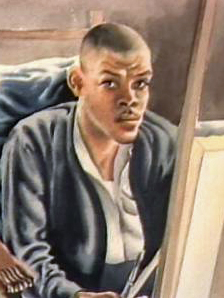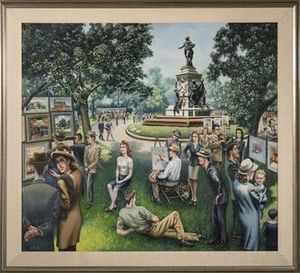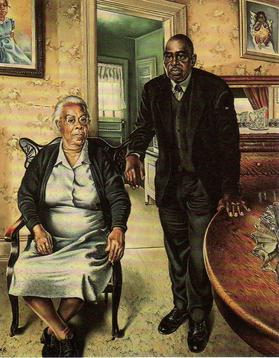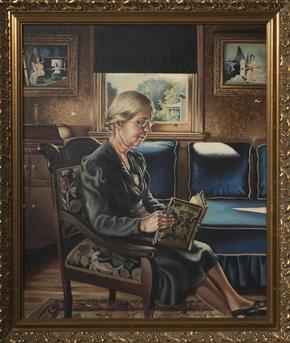John N. Robinson facts for kids
Quick facts for kids
John N. Robinson
|
|
|---|---|

"In the Studio", 1945
|
|
| Born |
John Nathaniel Robinson
February 18, 1912 |
| Died | October 17, 1994 (aged 82) |
| Nationality | U. S. citizen |
| Known for | Artist |
John N. Robinson (February 8, 1912 – October 17, 1994) was an African-American artist. He lived and worked in Washington, D.C.. He painted realistic pictures of people and places. These included his family home, his neighborhood, and the city itself.
People described him as "quiet and careful." His art was praised for its "sincerity and humility." He was especially known for his portraits. These paintings showed the true personality of the people he painted. One art critic said his paintings were like "hymns to the ordinary." They were "warmed by gratitude and gentleness."
Contents
Early Life and Learning to Paint
John N. Robinson was born in Washington, D.C., on February 18, 1912. When he was eight, his mother passed away. His father then left the family. John and his four brothers and sisters were raised by their grandparents.
He went to public schools but left before finishing junior high. While still in school, he started making small paintings. He worked part-time evenings at a car service station. His grandfather was a night watchman there.
The chauffeur of a client saw some of John's paintings. He showed them to his sister, who then showed them to James V. Herring. Mr. Herring was the head of the art department at Howard University. He arranged for John to study art with a Howard teacher, James A. Porter. In return, John helped with light cleaning chores.
John could not study with Mr. Porter for as long as he wanted because he needed to earn money. But he later said that what he learned at Howard was the "basis of my efforts in art." After leaving Howard, he continued to paint whenever he could. He painted "everything from church murals to door decorations." At 17, he painted his first mural. It showed Christ at Gethsemane at the Emmanuel Baptist Church in Anacostia. This led to more art jobs in African-American neighborhoods.
Art Career and Exhibitions
In the 1930s, John worked full-time. First, he was with the Civilian Conservation Corps. Then, he worked as a laborer at the Washington Navy Yard. In 1935, he found work at St. Elizabeths Hospital. Both places were close to his home in Anacostia.
He kept painting when he was not working. At St. Elizabeths, he sold portraits to his co-workers. In Washington, D.C., during that time, art galleries often separated artists by race. John, like other African-American artists, could not find a commercial gallery to show his work.
But starting in 1938, he eagerly joined outdoor art shows. These shows were put on by the Times-Herald newspaper. At these art fairs, he sold his paintings. He also made quick "minute sketches" of people passing by for 35 cents each. He became friends with other artists. These connections helped him get part-time work painting backgrounds for a photo studio. The painting shown here, "Art Fair" (1946), shows a crowd at one of these fairs in President's Park.
In 1943, a small, non-profit art gallery opened near Howard University. It was called the Barnett Aden Gallery. This gallery was special because it showed art by both African-American and white artists. In February 1945, John's paintings were part of a group show there.
Later that year, he won an award for his painting, "Mr and Mrs Barton." This was at the fourth annual Exhibition of Paintings at Atlanta University. This painting, shown here, is a portrait of his grandparents.
John's art was shown at the Barnett Aden Gallery again in 1946, 1947, 1948, and 1952. In 1947, the Evening Star newspaper showed his portrait, "Mother and Child." A critic wrote that John's natural paintings were "the most pleasing group." They mentioned his "speaking likeness of the Barnett Aden Gallery," a clever self-portrait, and a "sympathetic 'Mother and Child.'"
A year later, the American Veterans' Committee included John's work in their art show. The same critic praised his "amazing hard work, patience, and sharp vision." However, they also suggested he needed to simplify some of his paintings.
John did not seek out fame. His financial success was limited because he did not attend social events where artists met collectors. He once said, "I cannot, I feel, have any regrets about my accomplishments. What comes from art will just come. I don’t feel any need to strive." When his paintings started to sell for high prices, he would still sell them for less. He felt that many people who liked his art could not afford the higher prices. Because of this, his paintings sold for much more money after he passed away than they did during his life. In a 2004 auction, one painting sold for $9,500, and another went for $10,000.
Artistic Style and Themes
John Robinson was a realist painter. This means he painted things exactly as they looked in real life. He painted the people and places of his home, his neighborhood, and Washington, D.C. He was described as "quiet and careful." His art was based on "sincerity and humility." He painted people in a way that showed their unique character.
His work does not show anger about the difficulties he faced. He lost his parents when he was young and lived with poverty and racial unfairness. Instead, one critic said his art "brought back the days of traditional family life, love, and happiness." Critics liked his painting skills. But they sometimes felt he put too much detail into his work. They also thought some paintings were almost too sentimental.
A 1940 painting, "Woman Reading a Bible (Maude Jones)," is considered one of his best portraits. It was ordered by a woman who sold newspapers in downtown Washington. In 1994, John said he invited her to his house to pose. But after she sat for him several Sundays, she disappeared, and he never saw her again.
In his obituary, Richard Paul of the Washington Post called John's paintings "hymns to the ordinary." He said they were "intimate and accurate." He described them as "close studies of small domestic wonders." These included "fluorescent light reflected on a waxed linoleum floor," or "his children in the dining room," or "lilacs glimpsed in spring through the raindrops on a windowpane." He added that John's pictures were "warmed by gratitude and gentleness."
Personal Life
John Nathaniel Robinson was born on February 18, 1912. He grew up in a low-income area of Georgetown. This area was known as Holy Hill. As mentioned, his mother died when he was eight, and his father left. He was raised by his maternal grandparents, Ignatius and Anna Barton.
His grandfather, Ignatius (born around 1870), joined the U.S. Army in 1899. He became a Buffalo Soldier in the 9th and 10th cavalry regiments. He served during the Spanish–American War and the Philippine–American War. He later worked as a night watchman at a car garage. John described him as a kind man with a tough outside.
His grandmother, Anna (born around 1886), took in laundry. John and his siblings would help pick up and deliver it for her. He remembered her as "a warm lovely person."
John had four siblings. These included a sister, Margaret, and two brothers, Elgin and Henery. He went to Briggs-Montgomery Elementary School and Francis Junior High School in Washington, D.C. He left junior high before graduating.
In 1924, while still in school, John helped his family. He swept floors and dusted cars in the evenings at his grandfather's garage. After leaving school, he continued working at the garage. During the day, he did odd jobs and worked as a caddy at golf courses.
In 1929, he moved with his grandparents to a new home in the Garfield Heights area of Anacostia.
In 1933 and 1934, John worked for the Civilian Conservation Corps. This was a government program that provided jobs during the Great Depression.
In 1934, he married Gladys Ernestine Washington. They had several children: John N. Jr., twins Robert and Roberta, Ronald (called Pete), Douglas, Blanche, and Betty Anne. Until 1945, the family lived with Gladys's grandparents. Then, they bought a house across the street.
In 1935, after a short time at the Navy Yard, John got a job at St. Elizabeths Hospital. Over 35 years, he moved up from kitchen helper to cook, and then to supervisory cook. He retired in 1970. In the late 1930s and early 1940s, he also worked part-time painting backgrounds for photo studios. He said this extra work was a "great help in raising a large family during the Depression and war years."
John Robinson passed away on October 17, 1994. His wife, Gladys, passed away on May 23, 2016.




